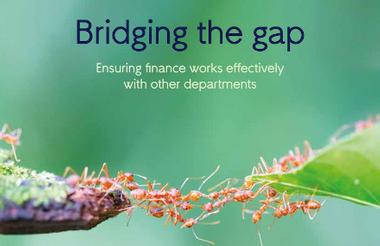The finance department within a charity has often been perceived as a back-office function. Traditionally, the view has been that it only manages cash flows, fills out spreadsheets, processes payrolls and oversees the organisation’s financial reporting. This in turn has resulted in many finance professionals working in silos and not feeling connected to their colleagues.
The Covid-19 pandemic challenged this misconception and kickstarted a change in working habits. Faced with significant reductions in income, charities had to revise their budgets and correct their cash flows to stay afloat. Finance teams were involved early in strategic discussions made by senior leadership teams and boards and helped to lead the sector’s response to the global health crisis.
An increasing number of charities are trying to bridge the gap between finance and other departments. But some still fail to see that the finance function is key to the success of their organisation and not an afterthought.
A changing role
The role of finance leaders has undergone significant changes over the years. No longer are they solely focusing on data and numbers to inform decision-making. They have become strategic leaders with oversight not only of finance but often also other areas such as HR, procurement and IT.
There is growing recognition across the sector that finance should play a driving role, as it does in the private sector, to create a solid foundation upon which charities can thrive and grow.
Robert Humphreys, who has held a number of finance positions including finance director and chief financial officer (CFO) at Oxfam GB and Oxfam International, agrees that finance teams used to be seen internally as purely administrative.
He says: “If you turn the clock back 20 or 25 years, I would agree that this would have been the norm in most charities. My experience is that medium and large-sized charities have all changed. They’re all now much more focused, professional and engaged. Charities have to listen to their staff and outside stakeholders. They can’t just carry on [thinking]: ‘That’s just the finance department.’ That’s the challenge for charity leadership, to break down those old tropes and replace them with a new dynamic that’s about ‘we’re all in this together’.”
Despite this, being a finance leader can be a lonely job. They can be seen as the “no” people and feel detached from the other departments. Humphreys believes that it is a natural tendency for individuals to work in silos. The challenge for charities, though, is to build both a structure and culture that encourage people to work across teams and boundaries.
The silo mentality
James Abbott, director of performance and corporate services at the Royal National Institute for Deaf People (RNID), has worked in charities where finance teams operated in silos.
He recounts: “In my first role I was in fundraising. What I found was that the finance team was demanding of its staff but wasn’t thinking about what value it was having or how it could help support the charity to achieve its objectives. It was just doing what finance always does and wasn’t considering itself to be providing a service to the organisation – almost thinking the other way around.”
At the time, Abbott had no financial experience but was being asked in his fundraising role to do things that the finance team should have been doing to help make decisions. “This is wrong and isn’t how it should be,” he says.
He now leads RNID’s finance and performance team, contact centre, people team, and governance and legal team. Since April, the charity has been producing a monthly pack that includes financial data and information about its reach, people and fundraising.
This wider performance brief, as he calls it, is shared with the whole charity, which allows staff to have access to data and trends in one place. Not only that, it also opens the door to help people understand what role the finance team can have and to start conversations.
He comments: “It breaks down those silos because to do a job of performance, finance has got to be in all of the conversations and plugged into everything. It’s just a good way of structurally setting out the vision for what you want to achieve.”
The initiative is part of RNID’s strategy to become a digital-first charity. To succeed, the charity identified that it had to crack corporate performance management. Abbott says: “That’s always been the gap. We’ve always had performance data but we’ve never been good at pulling it together and understanding the relationships between the different things. We just saw an opportunity to do it and pull it into the finance team’s brief.”
Another person who has had similar experiences of silos is Janie Oliver, CFO at Stewardship, a donor-advised fund for Christian givers.
Oliver says Stewardship has been on a journey to change that culture. The charity realised that it needed to take a business partnering approach to break down the silo mentality. It divided its team into financial control and business partnering and made a couple of strategic hires.
Business partnering is an approach whereby a member of the finance team is embedded in operations teams such as marketing. Their role is to bridge the gap between non-financial staff and leadership while guiding the organisation’s decision-making and strategy. They interpret raw data and financial jargon and present it in plain language so that everyone in the charity understands and feels involved.
Oliver says: “The financial control team needs to make sure that the numbers are all correct and the business partnering team needs to face off against the rest of the charity. Their skill set is around the relationship piece and reporting. Beforehand, we were expecting the main financial controller to do everything. Actually, he’s the details guy whose skill set isn’t about telling the story beautifully to non-financial people – he’s all about the numbers and spreadsheets.”
Before she joined the charity last year, Oliver explains that the finance director and other members of the leadership team would, for instance, do the budget without consulting the rest of the charity. Now, it is very much a process that involves everyone.
“We have an iterative process but what you have at the end is a budget that everybody’s signed up to, is accountable for and can report on over the year. Everybody understands their targets and all those sorts of things whereas before everybody said: ‘Well, I didn’t sign up to that budget at the beginning’, and it was quite easy [for them] to dodge their way around it.”
Finance teams have power
According to Abbott, finance teams have the power to change the way they are perceived across their organisations. “It’s the finance team’s job to build the bridges and show and prove what value it could have. I don’t think it ever starts with the charity knowing what it needs and how finance can help. A good finance team proactively goes and shows what it can do and changes the perception.”
As someone who oversees HR, he believes that the first step is to have a good finance business partner. “I’ve always put the most efforts into recruiting for those roles because those are the ones that make or break the approach. Those are the people who are out there building relationships. When I’m working with agencies on this recruitment, I always say: ‘This is far more about approach and mindset than it is about technical qualifications. What I want is somebody who can build relationships, open doors, make their way into the right meetings and demonstrate how they can help.’”
In Abbott’s experience, fundraising and finance tend to have a difficult relationship because of how different their people are. Fundraising teams may view finance as blockers, throwing a spanner in the works. Finance departments may see fundraising as doing its own things without considering the implications. That, he says, is where business partnering is crucial. “Once you’ve got that relationship, you can be there as a critical friend to help them and it opens the door. But you’ve got to open the door first and can’t just assume that it’s open and they get it.”
Seeing the bigger picture
Good communication and people skills are vital for finance teams. Often, the finance director – or CFO – is the sounding board for the chief executive officer and other members of the leadership team. They need to have a good overview of the organisation and be able to foresee any issues, risks and opportunities before they arise.
As well as understanding the intricacies of financial strategy, they need to be a strategic thinker, Oliver points out. “The person responsible for the finances has to be an effective communicator. The numbers will be used to make decisions so it’s up to the CFO to ensure the story that the numbers are telling is accurate, timely and understandable to everyone, not just to a select few people. If not, then poor decisions will be made.”
She continues: “Because of the nature of the information that you’re privy to, you also are often asked to provide input and advice about projects or initiatives that others come to you and seek advice and guidance on. This can sometimes be a bit of a sensitive nature so it’s important that you also have emotional intelligence and empathy to navigate those conversations.”
Abbott adds three more skills to the mix: relationship building, problem solving and pragmatism. Without relationships, people do not know what matters for the charity and do not keep their ears to the ground. And those who are good at solving problems and pragmatic come up with the right solutions and priorities. “All of that matters far more than technical ability because you can bring technical ability into your team and you can have the right experts to rely on. But if you’ve not got that mindset at the top, you won’t be able to do what the organisation needs you to do.”
He thinks that finance people who are obsessed over every last penny tend to be less effective. “Charities have limited resources and you’ve got to work out what matters and what doesn’t matter. It’s a bit like a spinning plate problem: which plates are you prepared to smash, which [ones] are critical? It’s standing back and seeing the big picture and understanding which things matter and which things don’t.”
Collective responsibility
Ultimately, accountability for the finances of a charity lies with its trustees. Guidance published by the Charity Commission in 2020 states: “As a trustee, you must take steps to make sure that your charity’s money is safe, properly used and accounted for. Every trustee has to do this. Even if your charity has an expert to manage its finances, you’re still responsible for overseeing your charity’s money.”
The closure of the high-profile youth charity Kids Company in 2015 thrust the financial responsibilities of trustees into the spotlight. The charity failed to build sufficient reserves despite warnings on the accounts seen by the trustees. Subsequent investigations revealed an “extraordinary catalogue of failures”.
In September, the Directory of Social Change (DSC) hosted its annual Charity Accountants’ Online Conference. The chief executive officer, Debra Allcock Tyler, gave attendees tips and advice on how to engage trustees with finance. She said there are five core challenges:
- Trustees say they don’t do the money.
- Trustees don’t understand and don’t ask.
- Trustees think they understand and don’t listen.
- They get lots of numbers and might then not feel confident to ask about them.
- Finance leaders do not explain the numbers and wait for trustees to ask.
A trustee herself, Allcock Tyler argued that it is part of finance professionals’ job to ensure that trustees are empowered to ask questions and engage with them.
However, she warned that trustees cannot delegate accountability either. “They need to understand the information they’ve been given and how to interrogate it. Very often, they don’t. It’s easy to blame trustees for not understanding but the reality is you’re coming to a meeting once a quarter, you’ve got a whole load of other things that have happened in the intervening three months and you’ve been worried about your own situation or organisation. Coming into a lengthy and detailed board meeting without help, it can be quite difficult to understand what you’re being told.”
She added: “There will be one or two trustees who dive into a tiny amount of detail, which isn’t particularly relevant to the organisation. Very often, they’re doing that because they haven’t understood the big picture. We have to give them the big picture, the information right up-front, which helps them understand what it is we’re telling them with the numbers, rather than just expecting them to be able to interpret the numbers for themselves.”
There are also examples of trustees who do not engage with finance and rely on their peers to support decisions that have financial ramifications. Oliver recalls being a treasurer at several small charities where trustees would look to her and say: “Janie, if you’re happy, we’re all happy.”
She says: “There are many charities where that’s probably similar, where you’ll have one trustee who knows a bit about the finances and that’s why they’ve been appointed and everybody looks to them. I would often encourage my fellow trustees to be happy with something because it’s not great for that trustee who’s got all that pressure and accountability sitting on their shoulders, but also because of the legalities around this in terms of all trustees needing to be comfortable.”
Regardless of their background and level of expertise, trustees need to have a basic understanding of, for instance, the difference between restricted and unrestricted funds and key papers such as the balance sheet and statement of financial activities.
Getting the culture right
Setting the right tone at the top is important, too. If charity finance teams are not integrated and do not work well with the other teams, then their organisations will struggle to thrive.
Humphreys comments: “If marketing staff bully finance for always saying ‘no’ and if finance staff think that fundraisers are just genetically incapable of working within the budgets that have been set, then that’s a real failure of leadership and communication.
“The finance director, CFO or chief operating officer is a leading part of the leadership team, not just somebody to tell them how much money is left in the bank. They should be fully participating in strategic discussions and representing the executive with the trustee body.”
For him, the finance leaders of the future will be at the forefront of steering their organisations to success. “The real excitement about being a finance director is about keeping the radar firmly fixed on the horizon so that the organisation doesn’t have any unpleasant surprises. It’s about working with your colleagues to structure the organisation so that everybody understands what its strategic priorities are.
“The external volatility means that it is more important than ever that we’re agile. We need calm hands at the wheel, particularly within the finance director role. People need to know somebody is there with their views firmly fixed on the horizon, and can see the icebergs coming up, and is going to make sure that we make those course corrections to avoid them.”
Six important tips
Here are some tips that Directory of Social Change’s Debra Allcock Tyler gave finance professionals during this year’s Charity Accountants’ Conference.
- It’s in your power. “Very often, we complain as the executive and finance folk that trustees aren’t staying at a strategic level but it’s our fault because we’re giving them non-strategic information. If we give them detail, it’s almost impossible for them to stay up there at the right level. How you present financial information to them will dictate where they stay in those conversations.”
- Detail is distracting. “The more detail you give them, the harder it will be for them to understand what it is you’re telling them.”
- Detail is the enemy of information. “Giving trustees a whole bunch of numbers isn’t giving them information. As finance folk, you need to be thinking: ‘What’s the information I want my trustees to understand as a result of reading my finance summary/report for the year or quarter?’ What is it you want them to take away? Frame your verbal section so that’s the information they’re getting. They don’t know how to interpret the data in the way we do when we’re so familiar with it.”
- Look at high level comparisons over time. “At DSC, we find it very useful to look at our performance, not just to get the budget for the year, but also what it looked like [the previous] year because that gives us a better sense of whether we’re moving in the right direction. It gives you information about whether your ambitions are too high and so forth. Always think about comparisons with previous years because that helps keep them at the right level.”
- Focus on forecasts. “If your trustees are spending most of their time talking about the figures that have gone, that’s partly our fault. It’s not necessarily helpful because that’s happened and there’s nothing to do about it. It’s making sure that you’re focusing on forecasts, saying: ‘Here’s the picture for the next coming few months; these are the actions we’re taking; this is what we anticipate happening.’ In your finance report, always include an opening summary paragraph of all the detail so that they’ve got something to cling on to.”
- Visuals, visuals, visuals. “Do not just give pages and pages of numbers, they’re not helpful. It’s much easier to stay at a strategic level if you see a graph, chart or something that gives you a sense of the patterns. If you want your trustees to stay at the right level, give them information that keeps them at that level and that will tend to be charts, graphs and pictures rather than sheets and sheets of detailed numbers. Use words, never just put a chart or a graph in without explaining what that information is telling them.”
Léa Legraien is senior reporter for Charity Finance
Related articles












